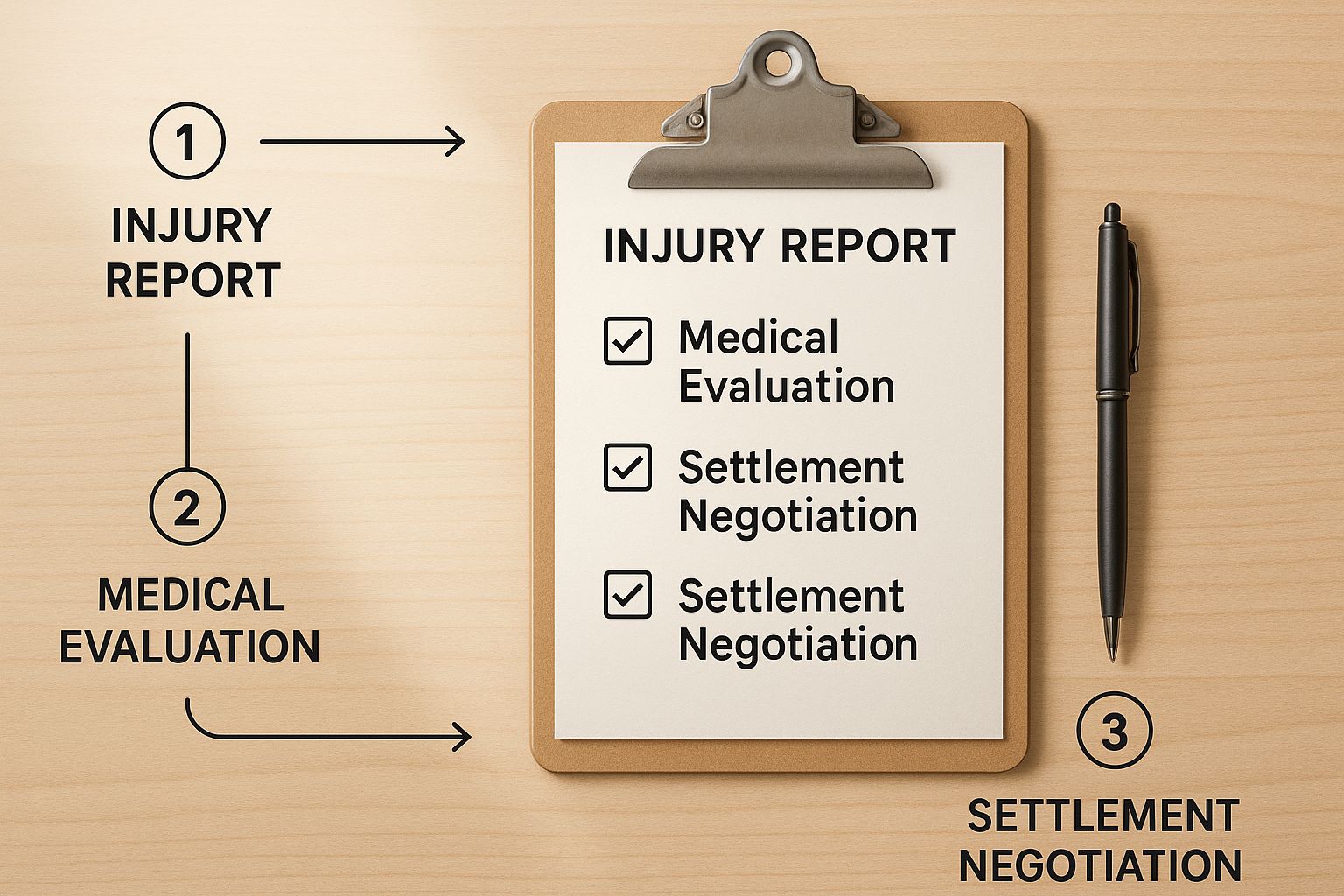Understanding Workers Comp Settlement Amounts | Your Guide
"I was satisfied once John Bell took over my case."
"Communication was always timely."
Understanding Workers Comp Settlement Amounts | Your Guide
When you hear about workers' comp settlements, the numbers can seem all over the map. Some cases resolve for a few thousand dollars, while others, involving catastrophic injuries, can reach well into the six figures. In Oregon, a settlement isn't just a number pulled from a hat; it's a carefully negotiated agreement designed to cover everything from your medical bills to the wages you lost while recovering.
What Is a Fair Workers Comp Settlement Amount?

It helps to think of a workers' comp settlement less like a jackpot and more like a detailed repair estimate for your health and financial stability. If you took a classic car to a body shop after an accident, the estimate would cover parts, labor, and even the diminished value of the vehicle. A fair settlement works the same way—it’s built to make you financially whole again after a work injury.
This agreement rolls all your potential benefits and financial needs into one final resolution. The goal is to give you the resources you need to manage your recovery and future without being tied to the uncertainty of weekly benefit checks.
The Building Blocks of a Settlement
So, what exactly goes into this "repair estimate"? Every fair settlement is built from several crucial components, each one addressing a specific loss you've experienced because of your injury.
Here’s a look at the key pieces that make up a typical workers' comp settlement amount.
Key Components of a Workers Comp Settlement
| Medical Bills | All past, present, and reasonably expected future medical care for your injury. |
| Lost Wages | The income you couldn't earn because you were out of work recovering. |
| Permanent Disability | Compensation for any permanent impairment or loss of function you have after reaching maximum medical improvement. |
Each of these elements plays a vital role in determining the final settlement figure. Of course, this all hinges on whether your claim is accepted in the first place. You can learn more about the requirements by reviewing your eligibility for workers compensation.
National Averages and Oregon's Reality
While every single case is different, looking at the big picture can give you some perspective. According to the National Safety Council, the average workers' compensation settlement in the U.S. is around $44,179.
That national figure provides a general baseline, but it's just that—a baseline. The reality is that settlement amounts can swing wildly based on Oregon's specific laws, the cost of medical care in your area, and, most importantly, the severity of your injury.
A settlement is not just about the injury itself; it's about the injury's ripple effect on your entire life—your ability to earn a living, pay for treatment, and maintain your quality of life.
Ultimately, a "fair" settlement is one that truly accounts for the full impact of your injury. It's about making sure you aren't left holding the bag for unexpected medical bills or financial hardship years down the road.
The Core Factors That Shape Your Settlement Amount

When it comes to calculating a workers’ comp settlement, there’s no guesswork involved. It’s a methodical process that hinges on a handful of crucial factors. Think of it like a recipe—you need the right ingredients in the right amounts to get the final result you’re looking for.
Understanding these key variables is the first step to seeing how the numbers in your case come together. Let’s break down the essential pieces that build the foundation of your settlement value.
The Severity of Your Injury
This is the big one. The nature and severity of your workplace injury set the stage for everything else that follows, from the medical care you’ll need to your ability to get back to your job.
An injury that heals quickly with minimal treatment will naturally lead to a smaller settlement. But an injury that demands surgery, long-term therapy, or leaves you with permanent work restrictions? That changes the entire conversation.
For instance, a minor wrist sprain might mean a few weeks off and some physical therapy. A career-ending back injury that requires a spinal fusion is a completely different story. The financial impact is immense, and the settlement will have to reflect that.
An injury's severity isn't just a medical diagnosis; it's the story of your recovery. A more complex story, involving surgeries, specialists, and permanent changes, will translate into a higher settlement value.
Your Average Weekly Wage
Your income before the injury, known as the Average Weekly Wage (AWW), is a critical number in the settlement equation. This figure acts as the baseline for calculating any lost wage benefits you’re owed. In Oregon, disability benefits are typically two-thirds of your AWW.
It’s simple math: a higher pre-injury wage leads directly to higher compensation for time missed from work. This has a ripple effect on the final settlement, as the insurer has to account for a larger potential payout over the life of your claim.
It's absolutely vital to make sure your AWW is calculated correctly. It should include everything:
- Regular pay: Your standard hourly wage or salary.
- Overtime: Any consistent overtime hours you worked.
- Bonuses and commissions: All regular performance-based pay.
- Second job income: If you were working another job at the time, that counts too.
Getting this number wrong is one of the most common ways injured workers get shortchanged. Double- and triple-checking this figure is a must.
The Permanent Impairment Rating
At some point in your recovery, your doctor will determine that you’ve reached Maximum Medical Improvement (MMI). This just means your condition is as good as it’s going to get. At this stage, they’ll assess you for any permanent impairment.
This assessment results in a Permanent Impairment Rating, which is a percentage that measures your permanent loss of function. Think of it as a medical score that gets converted directly into a monetary award. A 5% impairment rating for a knee injury results in a much smaller payout than a 20% rating for that same knee. Insurance adjusters rely heavily on this rating to calculate your permanent disability benefits.
Projected Future Medical Needs
A settlement isn't just about paying for the medical bills you already have. It’s also about covering the care you’re going to need down the road. If your injury will require ongoing treatment to manage pain or maintain function, that has to be factored into the final number.
The insurance company must estimate the cost of all reasonably necessary future care. This could include things like:
- Future surgeries or corrective procedures
- Lifelong prescription medications
- Ongoing physical or occupational therapy
- Medical devices like braces or walkers
- Regular check-ups with specialists
An experienced attorney will often work with medical experts to map out a detailed life care plan. This document provides a powerful, evidence-based projection of these future costs, giving you the leverage needed to negotiate a settlement that won’t leave you paying for your own medical care years from now.
How Workers Comp Settlements Are Calculated in Oregon
So, we've covered the key factors that influence your settlement. Now, let’s pull back the curtain and see how the numbers actually come together in Oregon. It’s not some mysterious black box; the process is actually quite structured, based on a formula that connects your wages to the long-term impact of your injury. Getting a handle on this math is crucial to understanding your final settlement value.
Think of it like a recipe. You start with your base ingredients (your wages), add a critical measurement (your impairment rating), and then follow Oregon’s specific instructions to get to the final result—your settlement. Let’s walk through this process together.
This chart illustrates the typical journey of a workers' comp claim, from the moment you report the injury all the way through to the final settlement negotiation.

As you can see, each step logically builds on the one before it, showing how a well-documented claim moves toward a fair resolution.
A Practical Calculation Example
Let's make this concrete. Imagine a delivery driver in Eugene hurts their knee on the job. Here are the specifics of their case:
- Average Weekly Wage (AWW): $950
- Injury: Torn meniscus that required surgery
- Permanent Impairment Rating: 20% impairment of the knee
How does this turn into a dollar amount for their permanent disability? In Oregon, the system assigns a set number of "degrees" to different body parts. A knee, for example, is valued at 150 degrees.
Here’s how we do the math:
Find the Value Per Degree: First, we need the compensation rate for each degree, which is tied to the state's average weekly wage. For this example, let's say that value is $1,100 per degree.
Determine the Degrees of Impairment: Next, we multiply the body part’s total degrees by the impairment rating. In our driver's case, it's 150 degrees (for the knee) x 20% (the impairment rating). This gives us 30 degrees of impairment.
Calculate the Final Award: Finally, we multiply the degrees of impairment by the value per degree. That's 30 degrees x $1,100, which equals $33,000.
This $33,000 is the starting point for the permanent partial disability (PPD) part of their settlement. It’s a straightforward, formula-based calculation that sets the stage for negotiations.
The Two Paths to Settlement: CDA vs. DCS
Once you have an idea of the numbers, you’ll face a major decision: how to settle your claim. In Oregon, this boils down to two distinct types of agreements: a Claim Disposition Agreement (CDA) or a Disputed Claim Settlement (DCS).
This is a true fork in the road. The path you choose has permanent consequences for your future rights and benefits, so it’s a decision that requires careful thought.
A significant part of determining your settlement involves complex calculations based on various data points. Understanding and applying data analysis best practices can provide accurate, fast insights into your potential settlement.
This choice doesn't just affect the settlement check; it also dictates your access to future medical care for your injury. Let's compare them side-by-side.
Settlement Types Comparison CDA vs DCS
When you're looking at a settlement, you're not just agreeing to a number—you're agreeing to a specific type of legal closure. The table below breaks down the fundamental differences between a CDA and a DCS.
| Claim Status | Closes your entire claim forever. | Resolves a specific dispute but may keep the claim open. |
| Future Medical Rights | You give up all rights to future medical care for the injury. | You can often retain your right to future medical care. |
| Payment Type | Typically paid as a single lump sum. | Can be a lump sum or structured payments. |
| When It's Used | Used when both parties agree to a full and final settlement. | Used when there is a disagreement over a denied claim or specific benefit. |
A Claim Disposition Agreement (CDA) is exactly what it sounds like: a full and final buyout. You get a lump-sum payment, but in return, you close the book on your claim for good. The insurance company is completely off the hook for any future medical treatment related to that injury. It offers finality and often a larger check upfront, but you carry all the risk of future medical problems.
On the other hand, a Disputed Claim Settlement (DCS) is more of a targeted fix. It’s used to resolve a specific point of disagreement, like when a claim is initially denied. With a DCS, you might settle that one issue while keeping your rights to future medical care intact. This provides a valuable safety net but usually means a smaller settlement amount, since the insurer stays on the hook for potential future care.
Choosing between a CDA and a DCS is one of the most critical decisions in the entire process. It demands an honest look at your medical outlook, your financial situation, and your personal comfort level with risk.
The Role of Medical Evidence and Impairment Ratings
When you file a workers' comp claim, your medical records are everything. They are the official, expert-written story of your injury, and every single note from a doctor's visit, physical therapy appointment, or test result adds another layer to that story.
Insurance companies don’t just take your word for it—they need hard proof. Consistent medical care creates a clear paper trail that proves how severe your injury is, what treatments you've undergone, and how it’s affected your ability to work. This documentation becomes the foundation of your entire settlement.
Reaching Maximum Medical Improvement
A key turning point in any claim is when your doctor says you've reached Maximum Medical Improvement (MMI). This doesn’t mean you’re magically healed or back to 100%. It simply means your condition has plateaued and isn't expected to get significantly better from here on out.
Hitting MMI is a big deal. It’s the signal to the insurance company that it's time to stop focusing on temporary benefits and start figuring out the permanent, long-term impact of your injury. This is when the real settlement negotiations begin.
How a Permanent Impairment Rating Is Determined
Once you’re at MMI, your doctor will assess you for any permanent loss of function. This evaluation results in a Permanent Impairment Rating (PIR), which is a simple percentage that puts a number on your level of disability. This rating is one of the most important factors driving your settlement amount.
Think of it this way:
- A 5% impairment rating to your shoulder might represent a minor but permanent loss of motion.
- A 30% impairment rating for that same shoulder points to a much more significant, life-altering disability.
This isn't just a doctor's opinion—it's a number that gets plugged directly into a legal formula to calculate your permanent disability benefits. A higher rating means a higher payout. It’s that simple.
Getting a handle on how this rating is calculated is critical. For a closer look, check out our guide on the workers comp disability rating process and how it shapes your claim.
Challenging a Low Impairment Rating
So what do you do if the insurance company's doctor gives you a rating that feels way too low? You don't have to accept it. You have the right to fight back, and doing so is often the most important move you can make to get the compensation you deserve.
This is where having thorough and accurate medical records really pays off. Understanding the benefits of medical voice charting and other documentation tools can make a real difference in the quality of your evidence.
Your best weapon for fighting a lowball rating is an Independent Medical Examination (IME). An IME is exactly what it sounds like: an evaluation by a neutral, third-party doctor who has never treated you before. This physician will review all your records, perform their own examination, and give an unbiased opinion on your level of impairment.
A strong IME report can completely change the game. It gives you credible, expert-backed proof to counter the insurance company’s low valuation and provides the leverage you need to negotiate a much better settlement.
Actionable Strategies to Maximize Your Settlement
Going through a workers' comp claim can feel like you're playing a game where the insurance company wrote the rulebook. But you're not powerless. By taking a few specific, proactive steps, you can protect your rights and have a major say in your final settlement amount. This is your playbook for getting the full compensation you deserve.
Think of these strategies less as suggestions and more as essential actions. Each one builds on the last, creating a solid, undeniable foundation for your claim.
The Do's of Protecting Your Claim
Maximizing your settlement starts the moment you get hurt. From that point on, everything you do—and everything you write down—can make a difference.
Here are the absolute must-do's:
- Report Your Injury Immediately: Don't wait. Tell your employer about your injury in writing as soon as you possibly can. Any delay gives the insurance company an opening to argue your injury didn't actually happen at work.
- Document Absolutely Everything: Start a journal. Track your symptoms, your pain levels, and all the ways the injury messes with your daily life. Make a note of every single workday you miss and every conversation you have with your boss or the insurer.
- Be Completely Honest with Your Doctors: Your medical records are the single most important piece of evidence you have. Be specific and truthful about what hurts and what you can't do. Never try to tough it out and downplay your pain, but don't exaggerate, either.
The Don'ts That Can Sabotage Your Settlement
Knowing what not to do is just as critical as knowing what to do. A few seemingly small missteps can wreck your credibility and shrink your settlement offer.
Watch out for these common traps:
- Posting on Social Media: Assume they are watching. Insurance companies absolutely will dig through your social media. A picture of you doing yard work or on vacation—even if it's from years ago—can be twisted to argue your injury isn't as bad as you claim.
- Accepting the First Offer: The first offer is almost always a lowball. The insurer is just seeing if you'll take a quick and cheap payout to make the problem go away. Never say yes without knowing what your claim is truly worth.
- Missing Medical Appointments: Skipping doctor's visits or blowing off physical therapy sends a bad message. The insurer will point to it as "proof" that you aren't taking your recovery seriously, and therefore, your injury must not be that serious.
Your actions throughout this process tell a story to the insurance company. When you are consistent, honest, and meticulous with your documentation, you show them you are serious about your recovery and expect to be treated fairly.
When to Bring in an Expert
Sometimes, you can do everything right and still hit a wall. You might find yourself dealing with an insurance adjuster who simply refuses to offer a fair settlement. This is the point where you need to level the playing field.
Hiring an experienced workers' comp attorney isn't giving up; it's a smart, strategic move to protect yourself. A good lawyer knows the insurance company's playbook and can counter their tactics with legal expertise and sharp negotiation skills. They make sure every part of your claim is valued correctly to maximize your settlement, letting you focus on what really matters—getting better.
Frequently Asked Questions About Workers Comp Settlements
It's completely normal to have a lot of questions as you get closer to the end of your workers' comp claim. To help clear things up, here are some straightforward answers to the questions we hear most often. Knowing this stuff can give you a lot more confidence as you head toward a resolution.
How Long Does It Take to Get a Workers Comp Settlement
There's no magic number here. A settlement can come together in just a few months, or it might take well over a year. It all boils down to the specifics of your case. If the injury is straightforward and the medical evidence is clear, things tend to move much faster.
On the other hand, several things can slow the process down:
- The seriousness of your injury and how long it takes you to reach Maximum Medical Improvement (MMI).
- Whether the insurance company decides to fight any part of your claim.
- The back-and-forth negotiation that happens between your lawyer and the insurer.
It can be tough, but patience is key. Rushing to the finish line often means leaving money on the table that you're entitled to.
Are Workers Comp Settlement Amounts Taxable
This is a big one, and the news is generally good. For the most part, workers' compensation benefits are not considered taxable income by either the IRS or the state of Oregon. This covers the money you receive for both medical bills and your lost wages.
But there are a few wrinkles to be aware of. If you also receive other benefits like Social Security Disability Insurance (SSDI), your settlement could have some tax implications. It’s always smart to have a quick chat with a financial advisor who can look at your specific situation and make sure there are no surprises come tax time.
The fact that your settlement is tax-free is a huge benefit. Just make sure you understand how it fits in with the rest of your financial picture so you can plan your future with confidence.
Can I Reopen My Claim After a Settlement
This is a crucial point, and the answer hinges on the type of settlement you agree to. If you sign a Claim Disposition Agreement (CDA), you’re agreeing to take a lump-sum payment and, in return, close your claim for good. That means you waive your rights to any future benefits for that specific injury, including medical care.
A Disputed Claim Settlement (DCS) is different. It's designed to resolve a particular disagreement within your claim. Signing a DCS might leave your right to future medical treatment open, which can be a vital safety net if your condition gets worse down the road. It's essential to understand exactly what workers compensation benefits you are entitled to before you sign any final paperwork.
Trying to handle a workers' compensation claim by yourself can feel overwhelming. At Bell Law, our attorneys focus on protecting your rights and fighting to get you the full and fair settlement you deserve. If you've been injured on the job in Oregon, contact us for a free consultation. We can talk through your case and show you how we can help. Learn more at https://www.belllawoffices.com.







